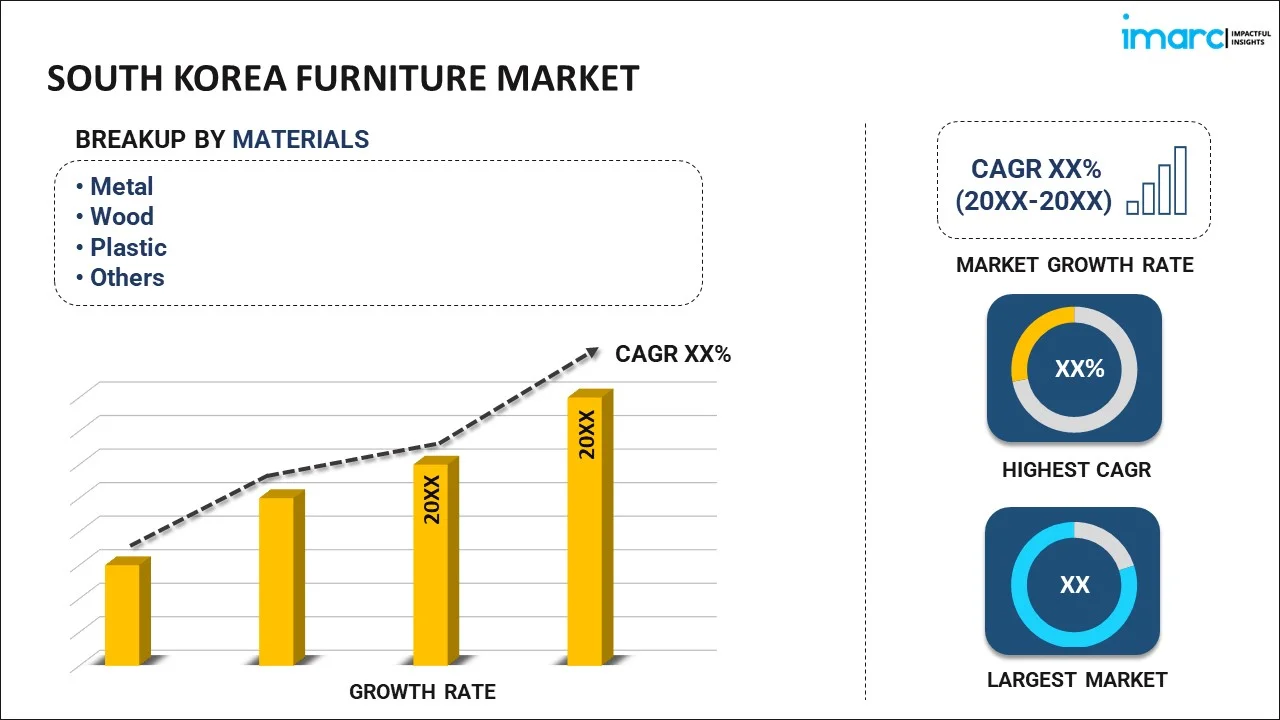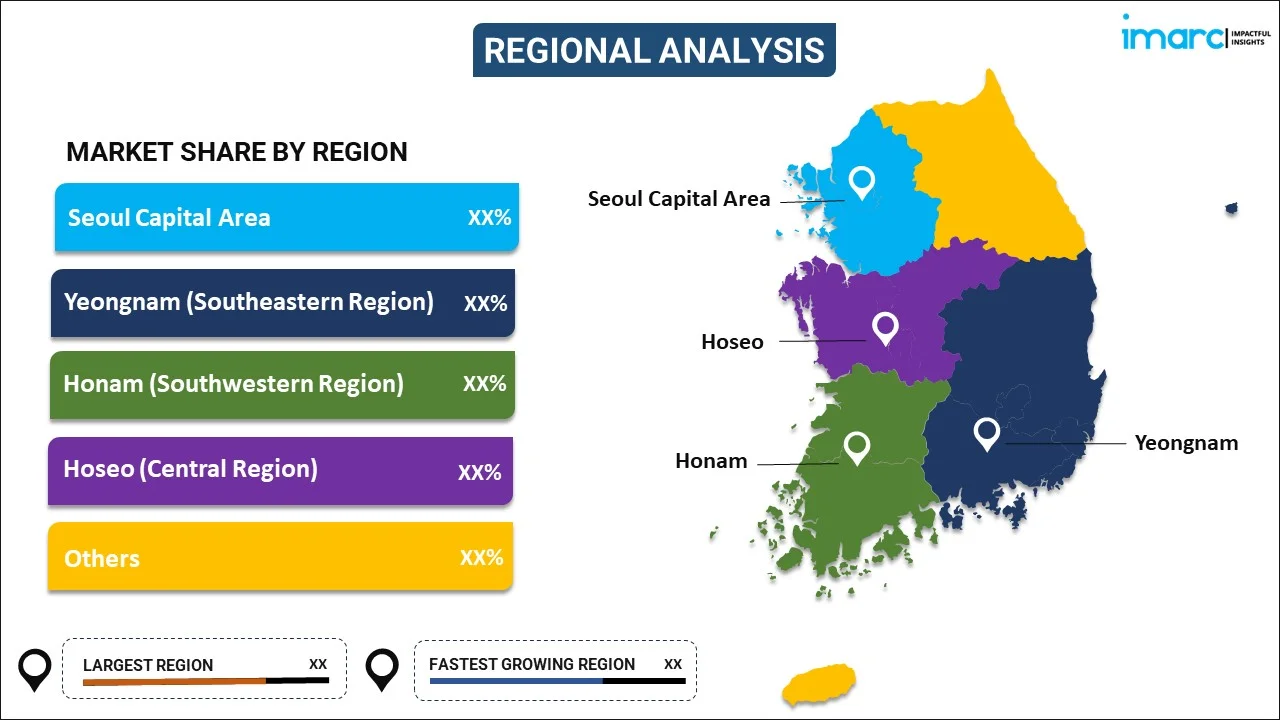
South Korea Furniture Market Report by Material (Metal, Wood, Plastic, Glass, and Others), Distribution Channel (Supermarkets and Hypermarkets, Specialty Stores, Online Stores, and Others), End Use (Residential, Commercial), and Region 2025-2033
Market Overview:
South Korea furniture market size is projected to exhibit a growth rate (CAGR) of 3.42% during 2025-2033. The incorporation of technology into furniture design, such as smart furniture with built-in electronics or ergonomic features, is driving the market.
|
Report Attribute
|
Key Statistics
|
|---|---|
|
Base Year
|
2024 |
|
Forecast Years
|
2025-2033
|
|
Historical Years
|
2019-2024
|
| Market Growth Rate (2025-2033) | 3.42% |
Furniture, the silent protagonist of the living spaces, serves as both functional and aesthetic elements, weaving the tapestry of homes and workplaces. From the practical simplicity of a chair to the luxury of an exquisite dining table, each piece tells a unique story. Beyond their practical roles, furniture pieces are reflections of culture, style, and individuality. They transform a mere shelter into a personalized haven, embodying tastes and preferences. The artistry and craftsmanship embedded in furniture design showcase the fusion of form and function, offering comfort without compromising on elegance. Whether it's the cozy embrace of a well-worn sofa or the sleek lines of a modern coffee table, furniture defines spatial dynamics and influences daily lives.
South Korea Furniture Market Trends:
The furniture market in South Korea is experiencing robust growth, driven by a confluence of factors that shape consumer preferences and industry dynamics. Firstly, the expanding regional population and urbanization trends have led to an increased demand for residential and commercial spaces, propelling the need for diverse and innovative furniture solutions. Additionally, changing lifestyles and a growing emphasis on interior aesthetics have stimulated consumers to invest in contemporary and customizable furniture, fostering market growth. Moreover, advancements in technology have revolutionized the furniture industry, with smart and multifunctional designs gaining popularity. Connectivity features, integrated storage solutions, and sustainable materials contribute to the evolving landscape of furniture offerings. Furthermore, the rise of e-commerce platforms has facilitated convenient access to a wide range of furniture options, influencing purchasing patterns and fostering market expansion. The heightened awareness of environmental sustainability is another key driver, with consumers seeking eco-friendly materials and manufacturing processes. This emphasis on sustainability not only aligns with changing consumer values but also reflects the industry's commitment to reducing its ecological footprint. In conclusion, the regional furniture market's upward trajectory is intricately woven with demographic shifts, technological innovations, e-commerce trends, and a growing environmental consciousness, creating a dynamic and thriving sector poised for continued growth.
South Korea Furniture Market Segmentation:
IMARC Group provides an analysis of the key trends in each segment of the market, along with forecasts at the country level for 2025-2033. Our report has categorized the market based on material, distribution channel, and end use.
Material Insights:

- Metal
- Wood
- Plastic
- Glass
- Others
The report has provided a detailed breakup and analysis of the market based on the material. This includes metal, wood, plastic, glass, and others.
Distribution Channel Insights:
- Supermarkets and Hypermarkets
- Specialty Stores
- Online Stores
- Others
A detailed breakup and analysis of the market based on the distribution channel have also been provided in the report. This includes supermarkets and hypermarkets, specialty stores, online stores, and others.
End Use Insights:
- Residential
- Commercial
The report has provided a detailed breakup and analysis of the market based on the end use. This includes residential and commercial.
Regional Insights:

- Seoul Capital Area
- Yeongnam (Southeastern Region)
- Honam (Southwestern Region)
- Hoseo (Central Region)
- Others
The report has also provided a comprehensive analysis of all the major regional markets, which include Seoul Capital Area, Yeongnam (Southeastern Region), Honam (Southwestern Region), Hoseo (Central Region), and Others.
Competitive Landscape:
The market research report has also provided a comprehensive analysis of the competitive landscape. Competitive analysis such as market structure, key player positioning, top winning strategies, competitive dashboard, and company evaluation quadrant has been covered in the report. Also, detailed profiles of all major companies have been provided.
South Korea Furniture Market Report Coverage:
| Report Features | Details |
|---|---|
| Base Year of the Analysis | 2024 |
| Historical Period | 2019-2024 |
| Forecast Period | 2025-2033 |
| Units | Million USD |
| Scope of the Report | Exploration of Historical and Forecast Trends, Industry Catalysts and Challenges, Segment-Wise Historical and Predictive Market Assessment:
|
| Materials Covered | Metal, Wood, Plastic, Glass, Others |
| Distribution Channels Covered | Supermarkets and Hypermarkets, Specialty Stores, Online Stores, Others |
| End Uses Covered | Residential, Commercial |
| Regions Covered | Seoul Capital Area, Yeongnam (Southeastern Region), Honam (Southwestern Region), Hoseo (Central Region), Others |
| Customization Scope | 10% Free Customization |
| Post-Sale Analyst Support | 10-12 Weeks |
| Delivery Format | PDF and Excel through Email (We can also provide the editable version of the report in PPT/Word format on special request) |
Key Questions Answered in This Report:
- How has the South Korea furniture market performed so far and how will it perform in the coming years?
- What has been the impact of COVID-19 on the South Korea furniture market?
- What is the breakup of the South Korea furniture market on the basis of material?
- What is the breakup of the South Korea furniture market on the basis of distribution channel?
- What is the breakup of the South Korea furniture market on the basis of end use?
- What are the various stages in the value chain of the South Korea furniture market?
- What are the key driving factors and challenges in the South Korea furniture?
- What is the structure of the South Korea furniture market and who are the key players?
- What is the degree of competition in the South Korea furniture market?
Key Benefits for Stakeholders:
- IMARC’s industry report offers a comprehensive quantitative analysis of various market segments, historical and current market trends, market forecasts, and dynamics of the South Korea furniture market from 2019-2033.
- The research report provides the latest information on the market drivers, challenges, and opportunities in the South Korea furniture market.
- Porter's five forces analysis assist stakeholders in assessing the impact of new entrants, competitive rivalry, supplier power, buyer power, and the threat of substitution. It helps stakeholders to analyze the level of competition within the South Korea furniture industry and its attractiveness.
- Competitive landscape allows stakeholders to understand their competitive environment and provides an insight into the current positions of key players in the market.
Need more help?
- Speak to our experienced analysts for insights on the current market scenarios.
- Include additional segments and countries to customize the report as per your requirement.
- Gain an unparalleled competitive advantage in your domain by understanding how to utilize the report and positively impacting your operations and revenue.
- For further assistance, please connect with our analysts.
 Inquire Before Buying
Inquire Before Buying
 Speak to an Analyst
Speak to an Analyst
 Request Brochure
Request Brochure
 Request Customization
Request Customization




.webp)




.webp)












